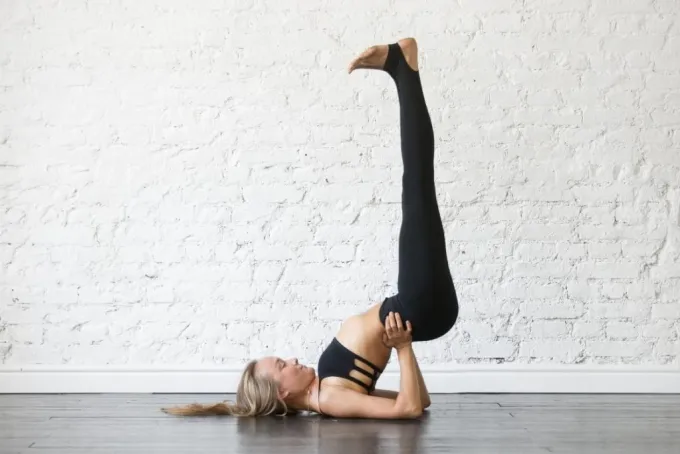Viparita Karani is referred to as a kind of Viparita Karani in classic yoga books.
Unlike simple hand mudras of yoga, In Kaya mudra, the whole body with breathing and concentration practice is combined together to perform a mudra.
The body position in Viparita Karani mudra looks similar to other inverted yoga poses like Sarvangasana (Shoulder Stand) and Sirsasana (Headstand). So often it’s also referred to as Viparita Karani Asana.
Yogis have noted numerous physical effects of Viparita Karani, including anti-aging, relief from constipation, an increase in hunger, fresh blood circulation, and a glow to the skin.
Viparita Karani Meaning
The words Viparita and Karani in this Sanskrit phrase denote, respectively, “Reverse” and “Action to attain a work.” When root phrases are combined, Viparita Karani refers to the “Action of reversing.”
Here in Viparita Karani Mudra, the flow of energy is reversed through reversing action; energy in the form of Soma (fluid).
In the Viparita Karani Mudra, the naturally upright body position is turned around such that the hands are at a 60-degree angle supporting the back. This “head down, legs up” position allows fluids to return to the skull, where they actually originated.
Difference Between Viparita Karani and Sarvangasana
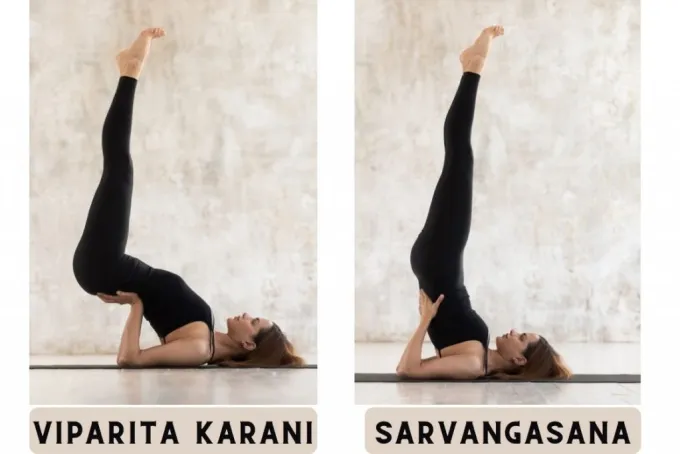
Viparita Karani is a flow-reversing process, not just an inversion pose like Sarvangasana, as should be stated here. Reversing the flow, on the other hand, indicates “moving back to the origin,” while inversion means “opposite to the flow.”
It demonstrates how Viparita Karani unmistakably adheres to the mudra system. Like all other mudras, it establishes an energy loop in the body by turning the fluid flow back toward the head, which prevents energy loss.
Viparita Karani
- In Viparita Karani, the back is not totally straight. It is slanted between 45 and 60 degrees.
- Here, the back’s suppleness keeps the throat’s muscles loose, allowing energy to flow into the Bindu chakra in the head.
- Viparita Karani is also known as a “half shoulder stand” because the shoulders aren’t under a lot of strain.
Sarvangasana
- The back and legs are at a 90-degree angle from the floor in Sarvangasana.
- Restrict energy flow to the throat chakra exclusively as the steep slope puts strain on the muscles there.
- Since the shoulders bear the majority of the body weight, the pose is known as the shoulder stand.
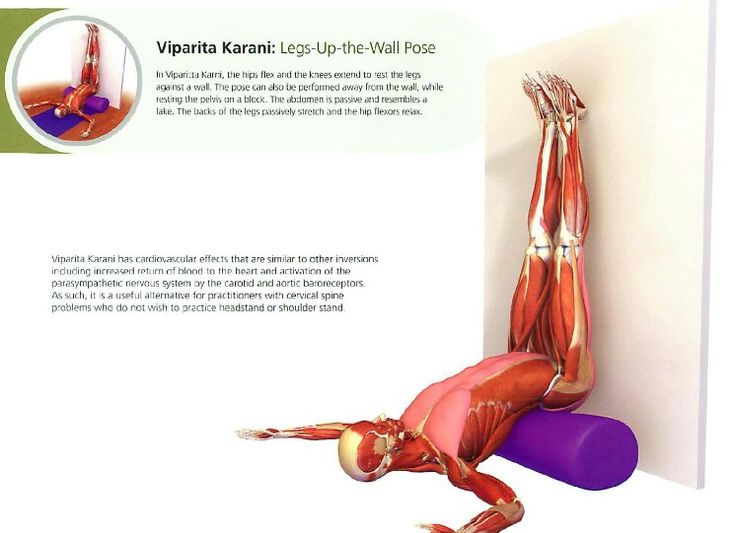
Viparita Karani Practice Guide
To properly perform Viparita Karani and its legs up the wall version, pay attention to the following guidelines.
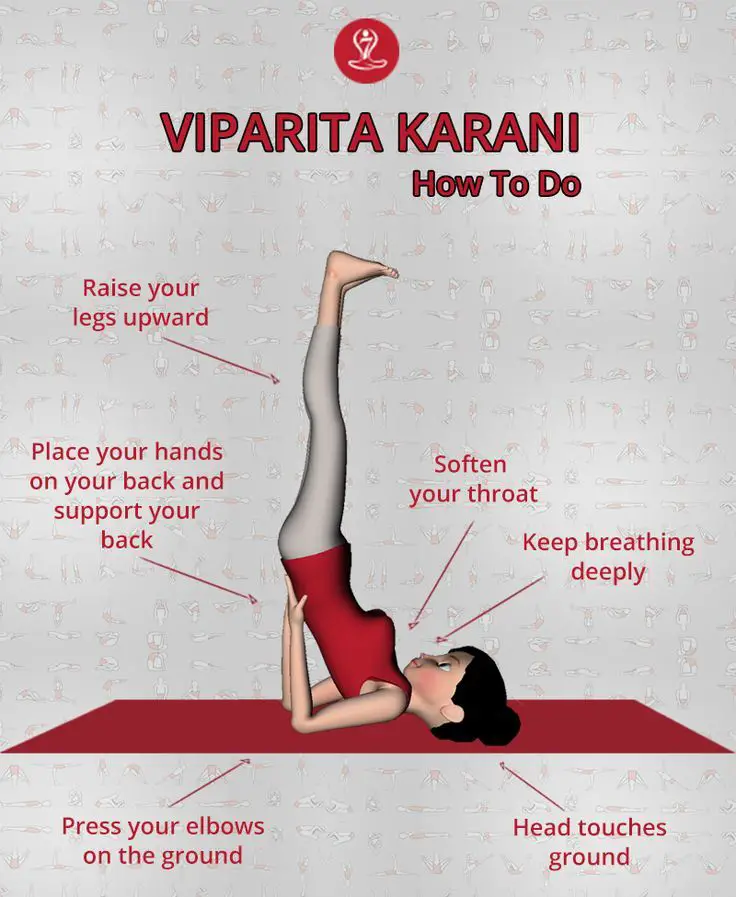
Precautions & Contraindications
- Make sure your bowels are empty before performing Viparita Karani. Do Laghoo Shankha Prakshalana before it, especially if you have constipation.
- If you have high blood pressure, heart illness, or thyroid issues, you should avoid this inversion position.
- Maintain a 6-hour window between practicing Viparita Karani and eating if you do it frequently.
- If you sense a heavy head, slowly exit the stance.
Follow the procedure below to perform Viparita Karani mudra;
How to Do Viparita Karani (Steps)
- Lay down on your back over your mat or a flat surface. Bring your hands so they are resting around your hips.
- Bending at the hip level, slowly bring your legs up until they are not perpendicular to the floor.
- Now, place your hands at waist level beneath your lower back and support your waist by grabbing it behind you.
- Slowly inhale, hold your breath, and then raise your legs and lower your back farther up while using your hands as support.
- To elevate your lower back and entire trunk, support it with your elbows and hands. Your trunk should be around 45 degrees angle from the ground.
- Straighten your legs in the air once the trunk is stabilized so that it returns to the floor at a 90-degree angle.
- Your inverted body weight should be shifted to your shoulders in the final position.
- Include Ujjayi breathing and the Khechari mudra in this last position if you are able to. Focus on the Manipura chakra as you inhale, then towards the end of the breath, shift your attention to the throat chakra, or Vishudhi chakra.
- Hold the position as comfortably as you can. Beginners should hold the pose for no less than three minutes, while skilled yogis can hold it for three hours (only under the guidance of a guru).
Release
- First, carefully lower the back and take away the hands’ support.
- Your palms should be on the ground.
- Then, without bending the legs, drop them to the ground.
Variation
When performed in its version, Viparita Karani’s asana genuinely turns into a peaceful restorative position.
Legs up the wall are one of its many popular variations. For beginners who can’t hold Viparita Karani for a few minutes, it’s a highly supporting technique. Here is how you do it;
Legs up the wall
You will require a folded blanket or a bolster to support your back when you are legs up the wall.
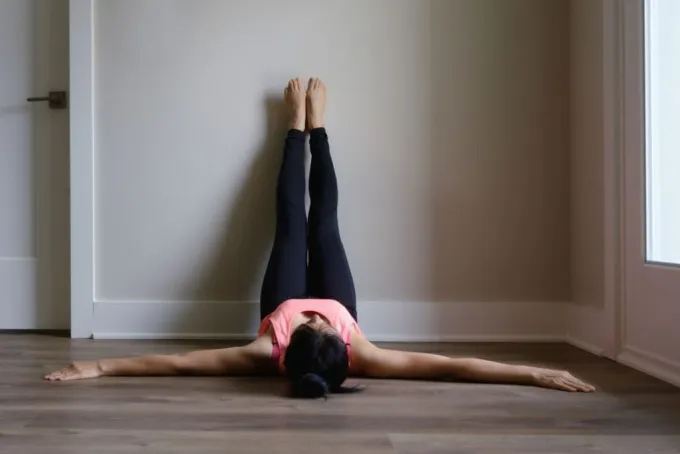
- Place your support first a few inches away from the wall. Sit with your legs straight out in front of you, between your support and the wall.
- Turn your legs up against the wall, exhale, and place your head and shoulders on the ground. Move your scrum forward and backward on the ground such that your hips are directly beneath your lifted legs.
- Continue to position your supine body on the floor so that your lower back is supported by the folded blanket or bolster.
- Your legs and back should be entirely supported by the wall.
- Hands might rest on the abdomen or just be laid sideways.
Best time to Perform Viparita Karani
Similar to other inverted yoga poses, Viparita Karani is best practiced first thing in the morning, immediately following a shower and bowel movement. The body’s metabolic and other processes are already at their height throughout the day. Reversing the body’s natural flow in this situation will have more negative impacts than positive ones.
It is possible to perform it in the afternoon, three hours after a typical lunch. Additionally, it ought to start after ten minutes of Shavasana rest.
Therapeutic Applications
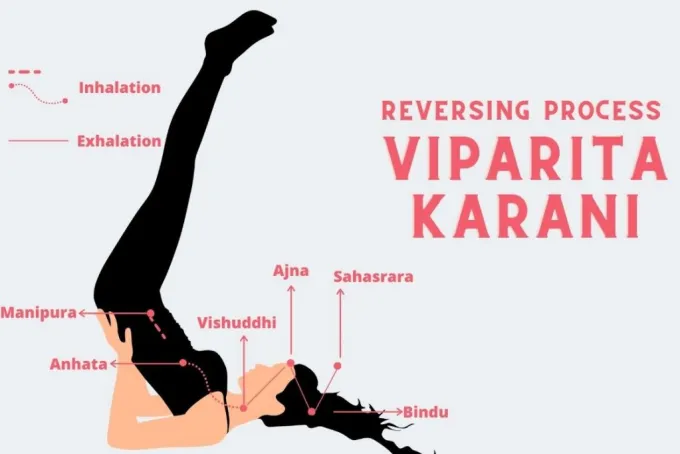
Viparita Karani has many therapeutic applications because of its inversion and flow-reversing process.
In the kriya yoga, it’s explained; aging is the result of the downward flow of nectar (fluid) from Bindu (in the head) to Manipura Chakra (in the navel). Viparita Karani reverses this flow of nectar back to the Bindu, hence working anti-aging exercise.
- With Viparita Karani, cerebral insufficiency and senile dementia can be effectively treated by increasing blood flow to the brain.
- Heals a certain kind of hernia, varicose veins, and hemorrhoids.
- Grey hairs and wrinkles become unnoticeable after six months of practice, according to the Hatha Yoga Pradipika (3.82). Three hours of Viparita Karani practice can defeat death.
- However, contemporary professors also advise practicing Viparita Karani to get rid of premenstrual syndrome, menopause, and menstrual cramps. [efn note] A single case study involving yoga therapy and menstrual disorders
http://www.indianjournals.com/ijor.aspx?target=ijor:ijner&volume=3&issue=1&article=012
- The thyroid gland is stimulated by the pressure applied to the muscles of the throat in this mudra. The hypoactive thyroid’s functions are restored to equilibrium.
Viparita Karani Benefits
- Viparita Karani’s “Legs up the wall” variant helps to relieve lower body tension and relax tight feet and legs.
- Activates throat chakra which gives you the ability to better express yourself, your emotions, and your creativity.
- Enhances the digestive process by increasing the release of digestive juices. Also possible is an increase in appetite.
- Increases in metabolism in body cells result in a reduction in fat around the waist in obese people [efn_note] Management of obesity through specific yogic procedure https://www.researchgate.net/profile/Yogesh_Deole2/publication/265026464 [/efn_note].
- When the head is turned upside down, collected cellular fluid from lower body parts enters the bloodstream.
- It improves vascular flexibility and tone, preventing atherosclerosis (a condition of fats, cholesterol, and other substances accumulating in artery walls).
- Beneficial for relieving a slight backache
- Gives a gentle stretch to the back of the neck, legs, front torso & pelvis.
- A study suggests [efn_note] Effects of Yogic Practices on Different Organs of an Athlete http://citeseerx.ist.psu.edu/viewdoc/download?doi=10.1.1.681.4563&rep=rep1&type=pdf [/efn_note] inversion poses like Viparita Karani strengthens the heart muscle, thus resulting in better circulation and less possibility of heart disease
















